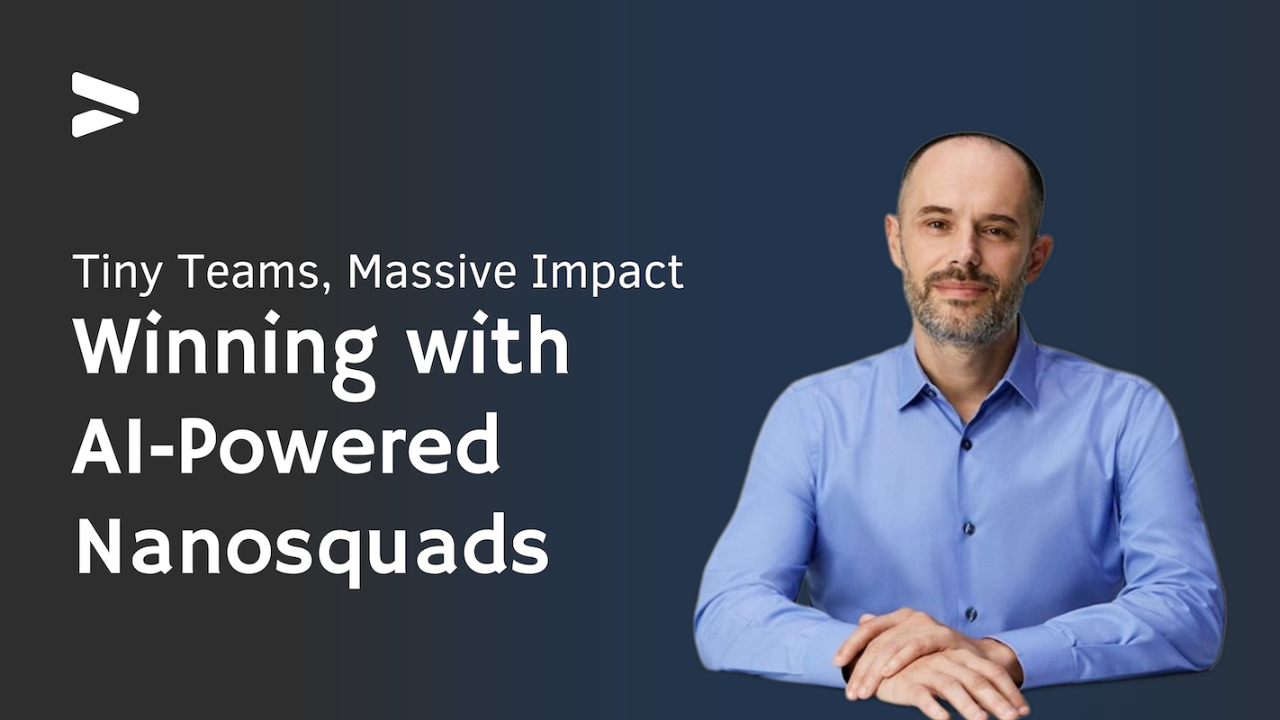
Tiny Teams, Massive Impact: Winning with AI‑Powered Nanosquads
May 03, 2025Picture four engineers lapping a sixty‑person department. The gap isn’t talent or budget anymore—it’s the ruthless combination of full autonomy and AI that does the heavy lifting humans once shouldered. Organize around these nanosquads and headcount stops dictating output—discipline does.
The Harsh Reality of Overgrown Teams
Bloated org charts look safe: more hands, more coverage, more “ownership.” In practice they grind progress to dust. Meetings multiply, decision latency balloons, and no one remembers who owns that festering microservice. While you’re syncing calendars, leaner competitors are shipping, learning, and stealing your users. Size isn’t leverage—speed is, and speed dies in committee.
Why We Cling to Large Headcounts
-
Fear of failure – More people feels like a bigger safety net.
-
Legacy org design – Layers of QA, Scrum, and DevOps made sense before GPT could write tests or infra in seconds.
-
Status theatre – Big teams stroke executive egos and hide fuzzy goals behind busywork.
All three are illusions. The longer you shelter inside them, the further you drift from the market’s pulse.
Break Free with AI‑First Nanosquads
Stop fetishizing 10× engineers; build 10× teams instead. Here’s the playbook that works:
Slice work by outcomes, not functions
Give a squad of 3‑5 full‑stack builders a single metric to move and full authority to ship without permission slips.
Demand AI at every step
• Engines generate workflows in a sandbox build—ready for instant feedback.
• Generative‑UX tools spin up wireframes and clickable prototypes before a designer ever opens Figma.
• Copilots propose 60‑70 % of new code.
• Repo‑aware agents review pull requests in minutes, not hours.
• LLMs auto‑draft tests, docs, release notes, and risk assessments.
If a task survives the AI gauntlet, only then is it worth human hours.
Set a hard cadence
Daily async stand‑up (auto‑summarized by a bot) and a Friday demo to real users. No ticket‑triage marathons. Deadlines create urgency; urgency ignites momentum.
Limit your options
Two viable approaches beat ten hypothetical ones. Fewer forks mean faster merges and clearer ownership.
Trust the gut—then measure the results
Data informs; instinct decides. Make the call, push to production, and watch the dashboards. Course‑correct live—don’t polish in limbo.
Accept—and exploit—mistakes
Every misstep is tuition for the next release. A squad that ships four imperfect versions learns faster than a committee that perfects none.
Stop Letting Legacy Processes Hold You Back
The biggest blocker isn’t AI capability—it’s cultural inertia. If your Definition of Done doesn’t require AI‑generated tests and documentation, you’re signaling that toil is acceptable. It isn’t. Refuse head‑count requests until teams prove AI can’t cover the gap. Once models are mandatory partners, people treat them like oxygen.
Make It Personal—Then Turn It Into a Game
What project is crawling because ten people “need” to weigh in? Split it. Give a nanosquad one north‑star metric—churn ↓ 2 pp, onboarding time ↓ 50 %—and full rights to deploy. Equip them with a 100 k‑token LLM wired to the repo. Then step back. Worst case, you roll back. Best case, you discover your new velocity baseline.
Fuel that autonomy with a game loop your engineers can’t ignore:
-
DORA is your friend. Publish lead time, deploy frequency, change‑fail rate, and MTTR every Friday. Hard numbers silence “we’re busy.”
-
Public velocity leaderboard. Rank squads on cycle time and AI‑assist %. Color‑coded shame outruns any memo.
-
Real‑world rewards. Hit 80 % copilot coverage or sub‑hour PR turnaround and the squad picks its prize: lunch with the CEO, a top‑spec laptop, or a three‑day off‑site.
-
Challenge sprints. Once a quarter, teams tackle a gnarly backlog item using only AI‑first workflows; winner chooses the next hack‑day theme—or locks in that reward trip.
-
Failure bingo. Track experiments that blew up; the fuller the card, the stronger the learning culture.
-
Instant rollback safety net. Automated revert scripts let squads chase leaderboard glory without sweating a prod meltdown.
Gamification plus DORA metrics turns autonomy into a visceral race. No one wants to be the team still chasing consensus while others rack up rewards—and results.
The Bottom Line
Indecision loves bloated teams. Autonomy loves small ones. AI tilts the field so violently that five disciplined builders with the right models will out‑deliver fifty waiting for approvals. The future won’t be won by the largest payroll—it’ll be won by the sharpest, fastest nanosquads wielding AI as an exoskeleton.
Final Thoughts
Stop overstaffing. Stop over‑architecting. Start organizing around tiny teams that treat AI as compulsory. Success won’t be measured by the decisions you deferred or the bodies you hired—it’ll be defined by the shippable value those nanosquads deliver today, next sprint, and every sprint after.
Now it’s your move: Which oversized project will you break into an AI‑powered nanosquad this week?